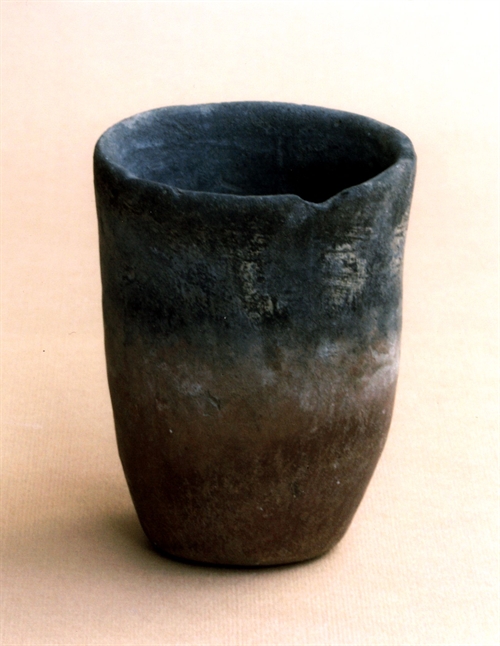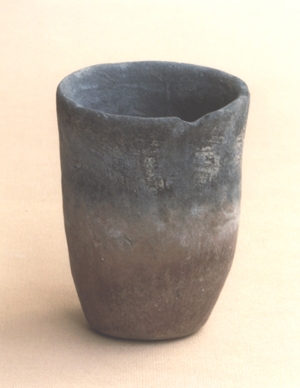The cup from Badari or early Naqada I culture

The clay cup is a rather small piece of pottery.
It is made of good cleansed burnished clay with polished outside surface. It was handily made and it is well preserved but colours are a little bit pale. Inside surface is painted from grey-black to dark brown. Outside surface is parted in two sections: upper section is painted black; bottom section is painted red-brown.
It shows characteristics of both Badarian and Naqada I period. Because of these characteristics it can be dated at Class BR black-topped polished red Badarian pottery or as the oldest Amratian SD 30 black-topped pottery.
The cup was probably used in everyday life. It is the oldest Egyptian artefact housed in Croatian museums.
When W. M. Flinders Petrie and J. E. Quibell, in 1894/1895, began digging a prehistoric necropolis and settlements of Upper Egypt near Naqada they found, among other objects, several types of pottery. After a few years of digging Petrie established a full sequence of the necropolis in 1899. Some decades later he wrote his well-known periodization of Naqada pottery but he was unable to establish any fixed dating. He marked the oldest sequence and materials as SD 30 and the period of the unification of Upper and Lower Egypt as SD 76. Excavations in the 20th century have changed dating of the oldest so-called Amratian sequence from SD 30 to SD 38 and the periods of the unification as SD 63. The common pottery from the earliest Amratian or Naqada I (circa 4000 – circa 3500 BC) period was black-topped and red painted. In the first decades of the 20th century Guy Brunton and Gertrude Caton-Thompson dug the necropolis and settlements of the El Badari region. They found a culture whose remains fall outside of the range of sequential dates made by Petrie and therefore they had allotted to them the numbers from SD 1 to SD 29. The pottery from the Badarian culture (circa 5500 – circa 4000 BC) is thinner than other forms made in Predynastic periods. The most unique type is black-topped and red painted pottery with a black inner surface.
Acquisition: Originally the collection was in the possession of the noble family Pasthory-Varady in the 19th century. In 1920’s these artefacts came in the possession of the Varaždin City Museum.
It is made of good cleansed burnished clay with polished outside surface. It was handily made and it is well preserved but colours are a little bit pale. Inside surface is painted from grey-black to dark brown. Outside surface is parted in two sections: upper section is painted black; bottom section is painted red-brown.
It shows characteristics of both Badarian and Naqada I period. Because of these characteristics it can be dated at Class BR black-topped polished red Badarian pottery or as the oldest Amratian SD 30 black-topped pottery.
The cup was probably used in everyday life. It is the oldest Egyptian artefact housed in Croatian museums.
When W. M. Flinders Petrie and J. E. Quibell, in 1894/1895, began digging a prehistoric necropolis and settlements of Upper Egypt near Naqada they found, among other objects, several types of pottery. After a few years of digging Petrie established a full sequence of the necropolis in 1899. Some decades later he wrote his well-known periodization of Naqada pottery but he was unable to establish any fixed dating. He marked the oldest sequence and materials as SD 30 and the period of the unification of Upper and Lower Egypt as SD 76. Excavations in the 20th century have changed dating of the oldest so-called Amratian sequence from SD 30 to SD 38 and the periods of the unification as SD 63. The common pottery from the earliest Amratian or Naqada I (circa 4000 – circa 3500 BC) period was black-topped and red painted. In the first decades of the 20th century Guy Brunton and Gertrude Caton-Thompson dug the necropolis and settlements of the El Badari region. They found a culture whose remains fall outside of the range of sequential dates made by Petrie and therefore they had allotted to them the numbers from SD 1 to SD 29. The pottery from the Badarian culture (circa 5500 – circa 4000 BC) is thinner than other forms made in Predynastic periods. The most unique type is black-topped and red painted pottery with a black inner surface.
Acquisition: Originally the collection was in the possession of the noble family Pasthory-Varady in the 19th century. In 1920’s these artefacts came in the possession of the Varaždin City Museum.
Catalogue entry
The clay cup from Late Badari or Naqada I period
The Varaždin City Museum, Varaždin
Archaeological department: Collection of the Ancient Egyptian artefacts
Inv. no. GMV AO-6521
Upper Egypt, unknown site
Late Badari or Naqada I period (c. 4500-3800 B.C.)
burnished clay: handmade
height: 8.9 cm,
section of rim: 6.8 cm
bottom section: 4.3 cm
private collection, Pasthory-Varady, 19th century
Resources
- Tomorad, Mladen. "Egipatske zbirke u Hrvatskoj s posebnim osvrtom na egipatsku zbirku Gradskog muzeja Varaždin". Zbornik radova međunarodnog simpozija Stvaralački potencijali u funkciji društveno-ekonomskog i kulturnog razvoja sjeverozapadne Hrvatske, Varaždin, 21.-22.11. 2002. Zagreb-Varaždin, 2002.: 543-558. 550-552.
- Tomorad, Mladen. „Egyptian prehistoric and early dynastic artefacts in Croatian museum collection“. Spomenica Josipa Adamčeka. Zagreb 2009: 539-546. 540-541.
- Tomorad, Mladen. „Foundation of the Ancient Egyptian Collections in Croatia: Travellers, Private Collectors and the Genesis of the Collections (1800-1920)“. U: Hudakova, Lubica; Hudec, Jozef (ur.). Egypt and Austria IX: Perception of the Orient in Central Europe (1800-1918). Krakow, 2016: 325-340, 405. 329, 339.
- Tomorad, Mladen. „The Ancient Egyptian Antiquities in Institutional and Private Collections in Croatia“. U: Tomorad, Mladen (ur.). A History of Research into Ancient Egyptian Culture conducted in Southeast Europe. Oxford, 2015: 31-58. 51.
- Tomorad, Mladen. „The Ancient Egyptian Collections in Croatia and the Project Croato-Aegyptica Electronica“. U: Derriks, Claire (ur.). Collections at risk: New Challenges in a New Environment - Proceedings of the 29th CIPEG Annual Meeting in Brussels, September 25-28, 2012, Royal Museums of Art and History Brussels, Belgium. Atlanta, 2017: 237-268. 256.
- Tomorad, Mladen. „The Egyptian antiquities in Croatia“. PalArch 2, 1 (2005): 1-33. 20.
- Tomorad, Mladen. Egipat u Hrvatskoj: egipatske starine u hrvatskoj znanosti i kulturi. Zagreb, 2003. 65, 67
- Tomorad, Mladen. Model računalne obrade i prezentacije staroegipatskih predmeta u muzejskim zbirkama u Hrvatskoj. [Doktorska disertacije, Filozofski fakultet u Zagrebu Sveučilišta u Zagrebu]. Zagreb, 2006. 30.
- Tomorad, Mladen; Uranić, Igor. "Egyptian Collection of the Museum of the City of Varaždin - Croatia". Trabajos de Egiptologia - Papers on Ancient Egypt 3 (2004): 87-98. no. 1, 88-89.

